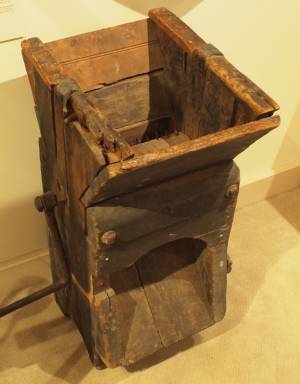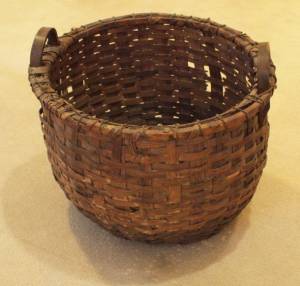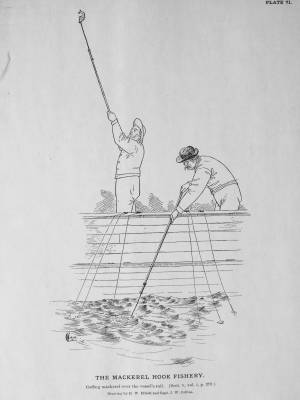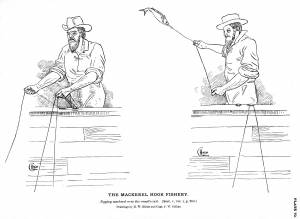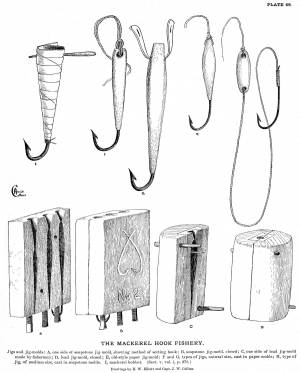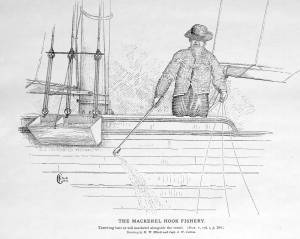An online project under the direction of the CAPE ANN MUSEUM
Historical Materials
Historical Materials » Maritime & Other Industries & Facilities » Mackerel Fishing
Mackerel Fishing
View related Fitz Henry Lane catalog entries (1) »
The mackerel is a migratory fish, wintering off the Eastern Seaboard between December and March, then heading north, reaching southern New England in May. While some small schools split off to go to spawning grounds south of Cape Cod, the main group swarms over Georges Bank, a rich feeding area which provides the extra nourishment to proceed to regional spawning grounds to the north. This feeding pause provided fishermen their first opportunity of the season for a plentiful catch of high quality, as the schooners from many ports gathered en masse to fill their holds.
Lane's painting, At the Fishing Grounds, 1851 (inv. 276), long thought to depict cod fishing, actually portrays mackerel jigging on Georges Bank during the spring migration. The schooner in left foreground is under shortened sail, alternately jogging and luffing to position itself broadside to the school, so all the crew is able to fish without fouling lines. The horizon is almost completely covered with sails, indicating how intent the mackerel fleet was on harvesting this resource.
The fishing method depicted is called jigging, so-named for the hooks, called jigs, which have lead weights cast on their shanks, an invention attributed to a Sandy Bay fisherman, Abraham Lurvey, in the early nineteenth century. The newly-cast lead is shiny and thus attractive to the mackerel, which will take the hook, often if unbaited.
Mackerel often swim close to the surface, especially when feeding. If hungry, they will bite at chum (ground-up fish used as bait) and jigs in a feeding frenzy, keeping the fishermen very busy.
Related tables: Fishing »
Mid-19th century
Base: 15" square Top: 15" x 19" Height: 36"
Gift of Capt. Ben Pine, 1946
Cape Ann Museum, Accession No. 1157
A hand-powered mill for grinding small bait fish (herring) into small bits called chum, which was kept in a chum box lashed to the side of the schooner amidships, on the starboard side, where the crew fished from the rail. As the mackerel swam under the schooner, chum would be tossed from the box with a large spoon in a process called tolling. If hungry, the mackerel would bite at the chum - and at fishing lines with mackerel jigs - in a feeding frenzy.
E.R.
Also filed under: Objects »
Wood, wicker, cordage
19 1/2 x 23 in.
Cape Ann Museum (2089-3 G/O EARR)
Used at wharfside for carrying fish and small fishing gear.
8 1/2 x 11 in.
Cape Ann Museum Library & Archive, Gloucester, Mass.
The mackerel gaff consisted of an iron rod 3-1/2 feet long with one or two barbs at the end, and socketed to a pole 10 to 12 feet in length. It was used to take mackerel when they were swimming around the schooner in great numbers but "not inclined to take the hook." By thrusting the gaff among the fish and rapidly withdrawing it, one or two mackerel could be caught at a time by a skilled user. This method fell out of use with the adoption of purse seining.
– Erik Ronnberg
Pencil and ink on paper
15 x 22 1/8 in.
Cape Ann Museum, Gloucester, Mass., Gift of Mr. Donald K. Usher, in memory of Mrs. Margaret Campbell Usher, 1984 (2401.19)
Also filed under: Beacons / Monuments / Spindles » // Gloucester Harbor, Outer »
8 1/2 x 11 in.
Cape Ann Museum Library & Archive, Gloucester, Mass.
Hand lines armed with jigs are dropped over the side, three to four lines per man. When a mackerel bites, the line is pulled up and the fish flipped or "jigged" over the rail. When the fish is on deck, a skillful fisherman can flip the hook out of its mouth without having to pick it up (the lead weight in the jig aids in this process). Small cleats on the rail hold the other lines secure during this process.
– Erik Ronnberg
8 1/2 x 11 in.
Cape Ann Museum Library & Archive, Gloucester, Mass.
Early mackerel jig molds were made by hand, using paper wrapped around the hook, a one-time for the mold. Soon thereafter, casting several hooks in a mold shaped from soapstone proved more efficient and productive. Molds made of lead were also used, allowing time for them to cool between castings. Iron molds led to commercial production of jigs by mid-nineteenth century.
– Erik Ronnberg
8 1/2 x 11 in.
Cape Ann Museum Library & Archive, Gloucester, Mass.
"Chum" (finely ground bait) is dipped from the "chum box" and scattered on the water to attract a school of mackerel. Fishermen lining the rail will catch the mackerel using hand lines with jigs.
– Erik Ronnberg
